The Ultimate Guide to a Balanced Diet: Your Path to Better Health
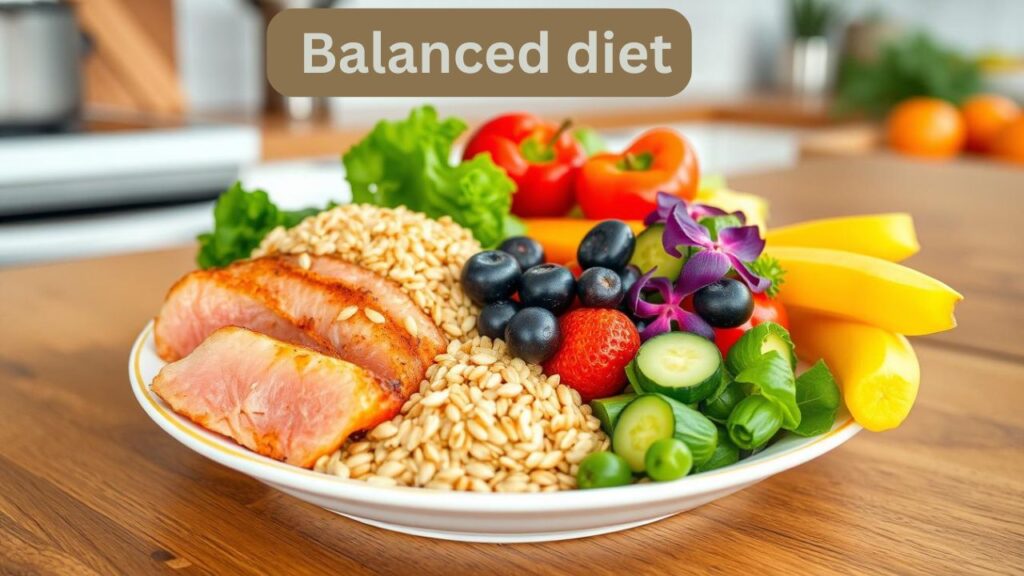
Thinking about your health and well-being? It all starts with your diet. A balanced diet is essential for good health, and it’s easier to achieve than you might think. By incorporating healthy eating habits into your daily routine, you can significantly enhance your quality of life. A balanced diet provides your body with the nutrients it needs to function properly, setting the stage for a healthier lifestyle.
Imagine a colorful array of fresh fruits and vegetables, beautifully arranged in a circular pattern. The vibrant colors and varied textures catch your eye, surrounded by wholesome grains, crunchy nuts, and lean proteins, all displayed on a rustic wooden table. Soft, natural lighting highlights the freshness of these ingredients, inviting you to dig in.
Eating well isn’t just about avoiding unhealthy foods; it’s about ensuring your body gets the nutrients it needs to thrive. By making small adjustments to your eating habits, you can reap the benefits of a balanced diet. Whether your goal is to lose weight, increase your energy levels, or simply feel better, starting with a balanced diet is a fantastic first step.
Introduction to Healthy Eating
That’s exactly right! A balanced diet is a personal journey, not a one-size-fits-all approach. Understanding your body’s unique needs and making informed food choices can help you create a diet that truly works for you. This guide will help you incorporate healthy eating into your daily routine, setting you on the path to better health.
Imagine this: You’re taking small steps each day, adding more colorful fruits and vegetables to your meals, choosing whole grains over refined ones, and incorporating lean proteins and healthy fats. Every meal becomes a conscious choice to fuel your body with the nutrients it needs.
Eating well is about progress, not perfection. By making gradual changes and listening to your body, you can develop sustainable habits that lead to a healthier, more vibrant life.
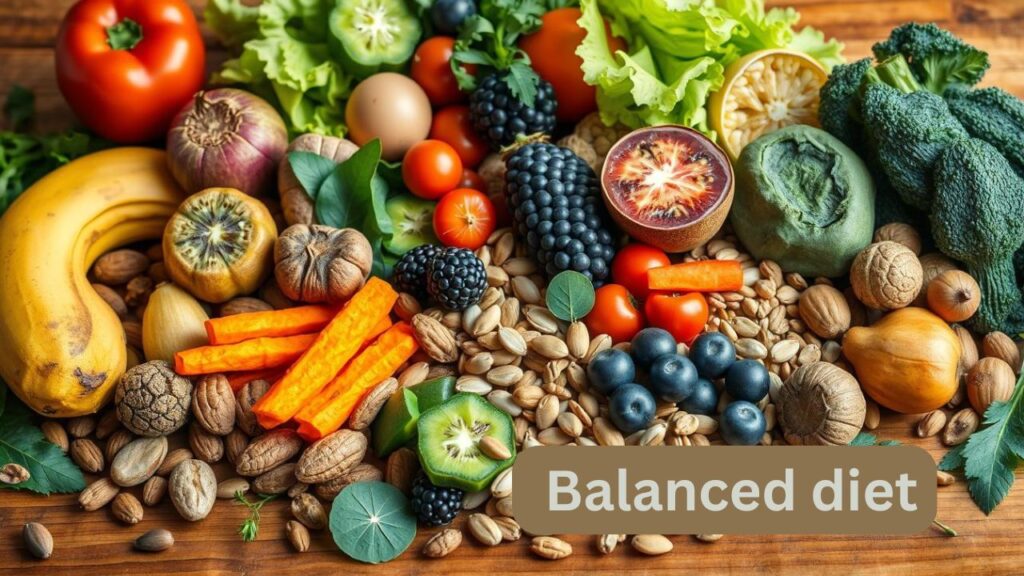
Key Takeaways
The Importance of Healthy Eating
- Maintain Good Health: Healthy eating is crucial for overall well-being.
- Nutrient-Rich: A balanced diet provides essential nutrients, vitamins, and minerals to keep your body functioning properly.
- Improve Quality of Life: Incorporating healthy eating habits into your daily routine can significantly enhance your life quality.
- Personalized Approach: A balanced diet is tailored to individual needs, making healthy eating a personal journey.
- Informed Choices: Making wise food choices is key to creating a balanced diet.
- Health Benefits: Eating a balanced diet can help with weight loss, boost energy levels, and improve overall health.
- Understanding What Makes a Balanced Diet
You’re right! Understanding nutrition science is essential for making smart food choices and maintaining a balanced diet. Each nutrient plays a vital role in keeping your body healthy and functioning optimally. Here’s a breakdown:
Starting Your Journey to Better Health
- Balanced Diet Basics: A balanced diet includes carbohydrates, proteins, fats, vitamins, and minerals. These nutrients work together to support your body’s overall health.
- Nutrition Science: Learning about the science of nutrition helps you make informed food choices. It’s important to find the right balance of nutrients, as too much or too little of any nutrient can be harmful.
- Carbohydrates: Provide energy. Too many can lead to weight gain, while too few can cause fatigue.
- Proteins: Essential for building and repairing tissues. Not enough protein can hinder muscle growth and repair.
- Fats: Important for brain function and hormone production. Healthy fats support overall well-being.
- Vitamins and Minerals: Crucial for supporting various body functions. Each vitamin and mineral has specific roles in maintaining health.
By understanding these key components, you can tailor your diet to your individual needs and set yourself on the path to better health.
Key Components of Nutrition
Absolutely! Nutrition science highlights the importance of getting a balanced mix of nutrients to maintain good health. Here’s a quick overview of these essential nutrients:
- Carbohydrates: These are your body’s main source of energy. They fuel your brain, muscles, and other vital organs.
- Proteins: Crucial for building and repairing tissues, proteins also play a role in enzyme and hormone production.
- Fats: Not all fats are bad! Healthy fats support brain function, hormone production, and absorption of vitamins.
- Vitamins: These organic compounds are essential for various bodily functions, including metabolism, immunity, and cell growth.
- Minerals: Inorganic elements like calcium, potassium, and iron are vital for bone health, nerve function, and blood health.
By understanding and incorporating these nutrients into your diet, you can ensure your body gets what it needs to function optimally.
The Science behind Balanced Eating
- Variety: Incorporate a wide range of foods to ensure you get all necessary nutrients.
- Whole Foods: Prioritize whole, minimally processed foods like fruits, vegetables, whole grains, nuts, and lean proteins.
- Balance: Aim for a mix of carbohydrates, proteins, and fats in your meals.
- Nutrients: Don’t forget those essential vitamins and minerals!
By sticking to these principles, you can enjoy delicious meals that nourish your body and keep you feeling your best.
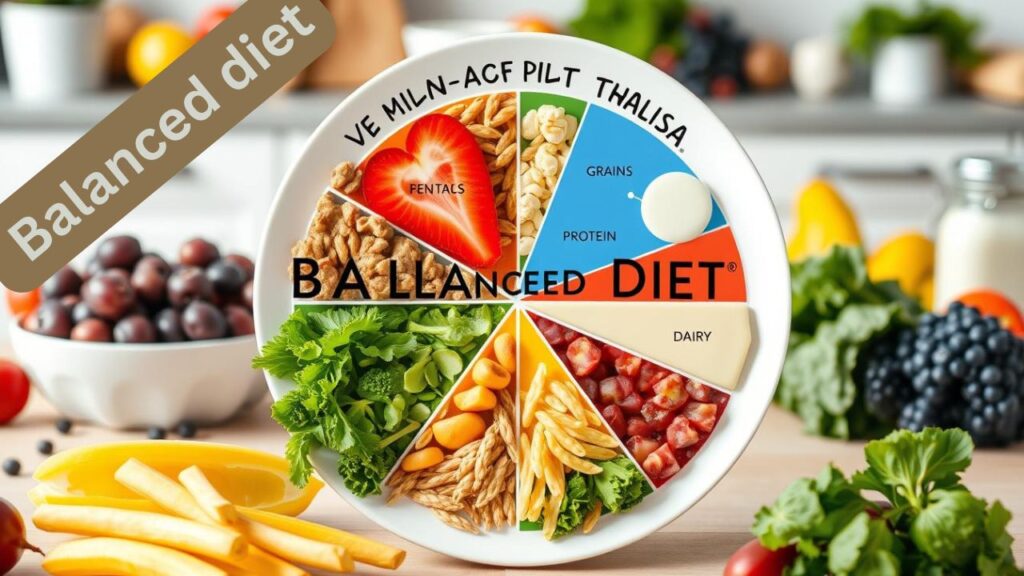
Why Balance Matters in Your Diet
- Nutrient Diversity: A balanced diet ensures you get a variety of nutrients. Different foods provide different vitamins and minerals that your body needs to function optimally.
- Preventing Health Issues: Consuming too much of one type of food while neglecting others can lead to nutrient deficiencies or excesses, which can cause health problems. For example, too much sugar can lead to weight gain and diabetes, while not getting enough calcium can affect bone health.
- Energy Levels: A balanced diet helps maintain stable energy levels throughout the day. Carbs provide quick energy, while proteins and fats ensure sustained energy release.
- Overall Well-being: A well-balanced diet supports your immune system, brain function, and overall mood. It helps you feel your best, both physically and mentally.
By understanding the principles of nutrition, you can create a diet plan that meets your unique needs and promotes long-term health. Remember, it’s all about balance and making informed choices!
Essential Nutrients Your Body Needs Daily
To maintain optimal health, it’s crucial to understand and meet your daily nutrient needs. A balanced diet ensures that your body receives the essential nutrients to function correctly. Here’s a breakdown of these key nutrients and their roles:
Key Nutrients:
- Proteins: Help build and repair tissues. Essential for muscle growth and overall body maintenance.
- Carbohydrates: Provide energy to fuel your daily activities. They are the primary source of energy for your brain and muscles.
- Healthy Fats: Support heart health, brain function, and hormone production. Include sources like avocados, nuts, and olive oil.
- Vitamins and Minerals: Support immune function and overall health. These micronutrients are vital for various bodily processes, from bone health to blood formation.
Why Variety Matters: Eating a variety of foods ensures you get a wide range of nutrients. Aim to include fresh fruits, vegetables, whole grains, nuts, and lean proteins in your diet. Imagine a vibrant and colorful plate filled with these nutrient-rich foods, set against the backdrop of a sunny kitchen. This diverse array of textures and colors not only makes your meals visually appealing but also ensures you get a balanced intake of essential nutrients.
Consulting a Professional: Understanding your daily nutrient needs and eating well is a fantastic start to a healthier lifestyle. However, it’s always wise to consult a doctor or dietitian to personalize your diet according to your specific health needs and goals.
The Power of Macronutrients in Your Diet
Understanding the importance of macronutrients—proteins, carbohydrates, and healthy fats—is essential for maintaining a balanced diet. These macronutrients provide your body with the energy it needs and are vital for overall health.
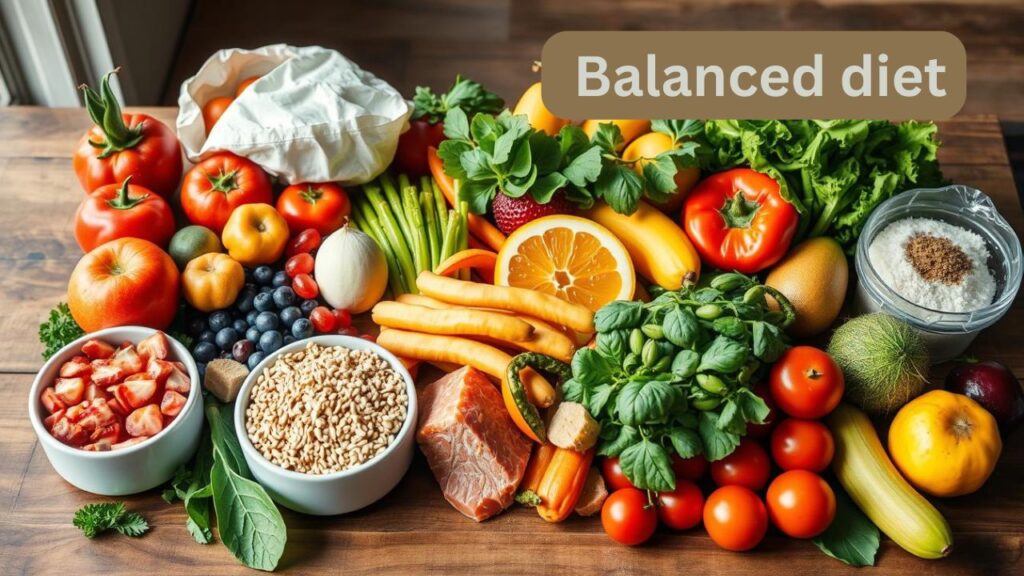
- Proteins: Help build and repair tissues, and are crucial for muscle growth. Sources include lean meats like chicken, fish, beans, and legumes.
- Carbohydrates: Provide the main source of energy for your body. Opt for complex carbs like brown rice, whole grains, and vegetables to keep you full and energized.
- Healthy Fats: Support heart health, brain function, and hormone production. Include sources like avocados, nuts, seeds, and olive oil in your meals.
Creating Balanced Meals: Combining these macronutrients in your meals ensures you get a well-rounded diet. For example:
- Pair lean proteins like chicken or tofu with complex carbs such as brown rice or quinoa.
- Add healthy fats like avocado slices or a handful of nuts for extra nutrition and flavor.
- Incorporate a variety of colorful vegetables to boost the nutrient content of your meals.
This approach not only keeps you full and energized but also supports your overall health and well-being.
By mixing these macronutrients in your meals, you’ll be able to enjoy a satisfying and nutritious diet that fuels your body properly.
Proteins: Building Blocks of Life Protein is crucial for fixing and growing tissues. You can find it in lean meats, fish, eggs, and dairy. Plant-based options like beans and legumes are also good sources. Adding protein to your meals helps you feel full. This can help you stay at a healthy weight.
Proteins: Building Blocks of Life
Proteins play a vital role in repairing and growing tissues, making them essential for your overall health. Here are some great sources of protein:
- Lean Meats: Chicken, turkey, and lean cuts of beef and pork.
- Fish and Seafood: Salmon, tuna, shrimp, and other fish.
- Eggs: A versatile and nutrient-rich source of protein.
- Dairy Products: Milk, cheese, yogurt, and other dairy items.
- Plant-Based Options: Beans, lentils, chickpeas, tofu, and other legumes are excellent plant-based protein sources.
Incorporating protein into your meals helps you feel full and satisfied, which can aid in maintaining a healthy weight. Whether you’re a meat lover or prefer plant-based options, there are plenty of ways to ensure you’re getting enough protein in your dist. vibrant, colorful plate filled with a variety of foods representing the three macronutrients: lean proteins, whole grains, and fresh fruits and vegetables, artistically arranged to emphasize balance and harmony, set against a soft, inviting kitchen background.
Carbohydrates: Your Energy Source Carbohydrates are essential for providing energy to your body. They can be found in grains, fruits, and vegetables. Whole foods like brown rice, quinoa, and whole grain breads are the best options because they are rich in fiber and provide sustained energy throughout the day.
Healthy Fats: Essential for Wellness Healthy fats plays a crucial role in maintaining heart health and energy levels. They are found in nuts, seeds, avocados, and olive oil. These fats help you feel full and satisfied, and they support your overall health by aiding in brain function and hormone production.
By incorporating a balanced mix of carbohydrates and healthy fats into your meals, you can ensure that your body gets the energy and nutrients it needs to thrive.
Micronutrients: Vitamins and Minerals Guide
Understanding micronutrients is key to maintaining your health. These essential nutrients, though needed in smaller amounts than macronutrients, play crucial roles in your body’s functions. Here’s a quick guide:
Important Micronutrients:
- Vitamin C: Essential for immune function and collagen production. Found in citrus fruits like oranges and lemons.
- Calcium: Vital for bone health. Common sources include milk, cheese, and leafy greens.
- Iron: Necessary for healthy red blood cells. Available in foods like red meat, spinach, and legumes.
- Potassium: Supports heart health and muscle function. Found in bananas, potatoes, and avocados.
Why Variety Matters: Eating a diverse range of foods ensures you get enough of these vital micronutrients. Fresh fruits, vegetables, whole grains, lean proteins, and healthy fats are all excellent sources. Imagine a vibrant and colorful arrangement of various fruits, vegetables, nuts, and seeds on a wooden table, showcasing an array of vitamins and minerals. The natural lighting enhances the freshness and nutritional appeal of the food.
Incorporating foods rich in micronutrients into your diet supports your overall health, helping your body get the vitamins and minerals it needs to function well.
Professional Advice: For personalized dietary recommendations, always consult a doctor or dietitian. They can help you tailor your diet to meet your specific health needs.
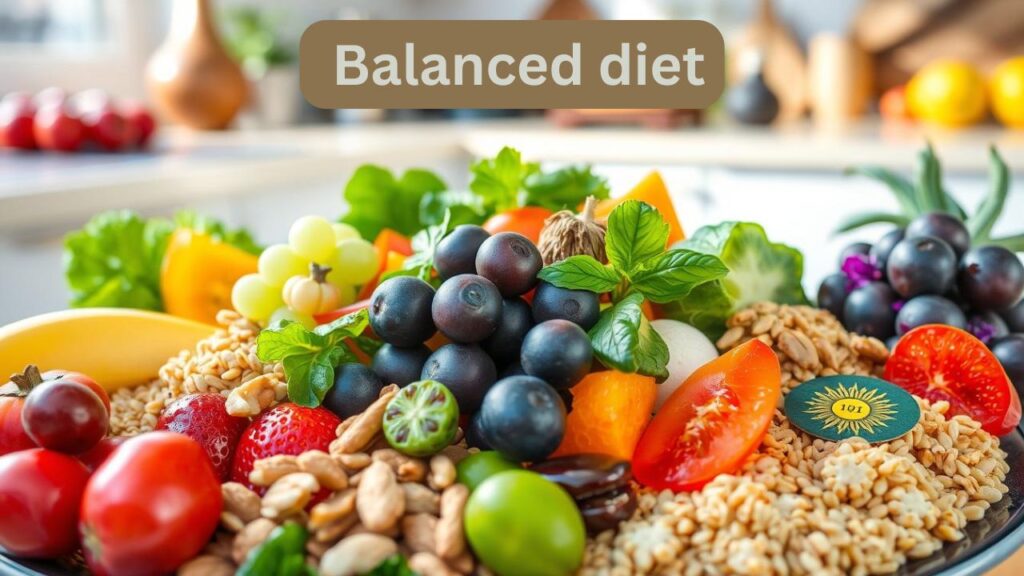
Micronutrients: Sources and Functions
These micronutrients play vital roles in maintaining your health. Ensuring you get enough of these nutrients through a balanced diet helps support various bodily functions, from bone health and muscle function to immune support and wound healing. By including a variety of nutrient-rich foods in your daily meals, you can provide your body with the essentials it needs to thrive.
Creating Your Personalized Balanced Diet Plan
To achieve a balanced diet, you need a plan tailored to your lifestyle and taste preferences. Here’s a step-by-step guide to help you get started:
1. Assessing Your Nutritional Needs
- Nutritional Assessment: Begin with a thorough assessment of your nutritional needs. This involves understanding what nutrients your body requires to function optimally.
- Consult a Professional: Speak with a health expert or dietitian to get personalized advice. They can help you identify your specific nutrient requirements and create a diet plan that suits you.
2. Setting Realistic Goals
- Calorie Needs: Determine how many calories you need based on your age, gender, activity level, and health goals.
- Macronutrient Balance: Find the right mix of proteins, carbohydrates, and healthy fats to fuel your body.
- Vitamins and Minerals: Ensure you get enough essential vitamins and minerals for overall health.
3. Building Your Diet Plan
- Variety: Incorporate a diverse range of foods to get a balanced intake of nutrients. Include fruits, vegetables, whole grains, lean proteins, and healthy fats.
- Meal Planning: Plan your meals to include a balanced mix of macronutrients and micronutrients. For example, pair lean proteins like chicken with complex carbs such as brown rice, and add healthy fats like avocado or nuts.
- Monitor Progress: Keep track of your dietary habits and make adjustments as needed. Regularly consult with your dietitian to refine your plan.
Nutritional Needs and Food Sources Understanding your nutritional needs are the foundation of a balanced diet. Here’s a quick reference for some essential nutrients and their sources:
| Nutrient | Food Sources | Function |
| Proteins | Lean meats, fish, eggs, dairy, legumes | Build and repair tissues |
| Carbohydrates | Grains, fruits, vegetables | Provide energy |
| Healthy Fats | Nuts, seeds, avocados, olive oil | Support heart health, energy |
| Vitamin C | Citrus fruits, berries, bell peppers | Immune function, collagen production |
| Calcium | Dairy products, leafy greens, fortified foods | Bone health |
| Iron | Red meat, spinach, legumes | Red blood cell production |
| Potassium | Bananas, potatoes, avocados | Heart health, muscle function |
| Vitamin D | Fatty fish, fortified dairy products | Bone health, immune function |
| Magnesium | Dark leafy greens, nuts, seeds | Muscle and nerve function, heart health |
| Zinc | Lean meats, seafood, beans | Immune function, wound healing |
By following these guidelines and personalizing your diet plan, you can set yourself on the path to better health and well-being.
Setting Realistic Dietary Goals
- Make it Personal: Design a meal plan that fits your life and tastes. This way, you can stick to it and get the nutrients you need.
- Set Achievable Targets: Establish goals that are both attainable and sustainable.
Building Your Meal Schedule
- Plan Ahead: Create a meal schedule considering calories, macronutrients, and vitamins. Planning ensures you get the nutrients your body needs to thrive.
- Balanced Meals: Aim for a mix of proteins, carbohydrates, and healthy fats in every meal.
Smart Portion Control Strategies
- Measure Portions: Use a food scale or measuring cups to control portion sizes.
- Visual Cues: Compare your food portions to the size of your fist or palm to estimate serving sizes.
- Tips for Portion Control:
- Eat slowly and stop when you feel satisfied, rather than stuffed.
- Use smaller plates to make portions appear larger.
- Avoid eating in front of the TV or while distracted to prevent overeating.
Reading Food Labels like a Pro
- Check Nutritional Info: Look at the nutritional information on labels, focusing on serving sizes, calories, and nutrients.
- Watch for Hidden Ingredients: Choose foods with less added sugars, saturated fats, and sodium. Check the ingredient list for any allergens or unwanted ingredients.
Reading Food Labels like a Pro
Understanding food labels is essential for making smart food choices. These labels provide important nutritional information that helps you select healthier options. Here’s how to read them effectively:
Checking Nutritional Info
- Serving Sizes: This section tells you the serving size and the number of servings per container. It helps you understand how much of the product you should consume.
- Calories: Indicates the number of calories per serving, helping you manage your energy intake.
- Nutrients: Look for the amounts of various nutrients, including fats, carbohydrates, proteins, vitamins, and minerals. Aim for foods with less added sugars, saturated fats, and sodium.
Ingredient List
- Allergens: Check for any allergens that might affect you.
- Unwanted Ingredients: Look out for added sugars, unhealthy fats, and artificial additives.
Understanding Nutritional Information
Nutritional labels are designed to be straightforward. They show:
- Serving Sizes and Servings per Container: Helps you determine how much you’re eating.
- Nutrient Amounts Per Serving: Allows you to compare different products and choose the healthier option.
Tips for Reading Labels:
- Focus on Whole Foods: Foods with fewer ingredients are generally healthier.
- Watch Out for Hidden Sugars: Ingredients like high fructose corn syrup, sucrose, and dextrose are all forms of sugar.
- Understand Daily Values: Percent daily values help you understand how a serving of the food contributes to your overall daily diet.
By mastering the art of reading food labels, you can make informed decisions and choose foods that support a balanced diet and better health.
Identifying Hidden Ingredients
Some foods hide ingredients that may not be listed prominently on the label. These can include added sugars, artificial flavors, and preservatives. To spot these, read the label carefully for terms like “high-fructose corn syrup” or “artificial flavor.” Always check for allergens or ingredients you prefer to avoid.
Making Informed Food Choices
By understanding labels and nutritional information, you can make smarter food choices. Look for foods that are:
- Low in added sugars, saturated fats, and sodium
- High in fiber, protein, and healthy fats Compare products using the labels to choose the healthiest options. Making informed choices can help you eat well and reduce the risk of disease.
Meal Planning for Success
Successful balanced eating begins with meal planning. By planning your meals ahead, you ensure that you get the nutrients your body needs. Here’s how to start:
- Create a Meal Calendar: Use a physical or digital calendar to list all your meals and snacks for the week.
- Grocery List: Make a list based on your meal plan and shop accordingly.
Tips for Effective Meal Planning:
- Plan meals around seasonal ingredients for freshness and variety.
- Choose meals that align with your dietary goals and restrictions.
- Prep meals in advance to save time during the week.
- Be flexible and adjust your plan as needed.
Shopping Guidelines for a Balanced Diet
Healthy shopping is the foundation of a balanced diet. Start by making smart shopping lists that include:
- Fruits and vegetables
- Whole grains
- Lean proteins
- Healthy fats
Shopping Tips:
- Plan your meals for the week to avoid fast food.
- Shop the store’s perimeter for fresh foods.
- Choose store-brand or generic options for better prices.
Healthy shopping habits can significantly improve your health. A balanced diet involves not just what you eat but also how you shop for it. With some planning, healthy shopping becomes easier, and you’ll enjoy the benefits of a balanced diet.
Quality Ingredients: Choosing quality ingredients is essential. Look for foods low in added sugars, salt, and unhealthy fats. Opt for whole foods over processed ones. Always check food labels to ensure you’re getting the right nutrients.
By following these guidelines, you can develop a balanced diet that supports your overall health and well-being. Ready to dive into meal planning and healthy shopping?
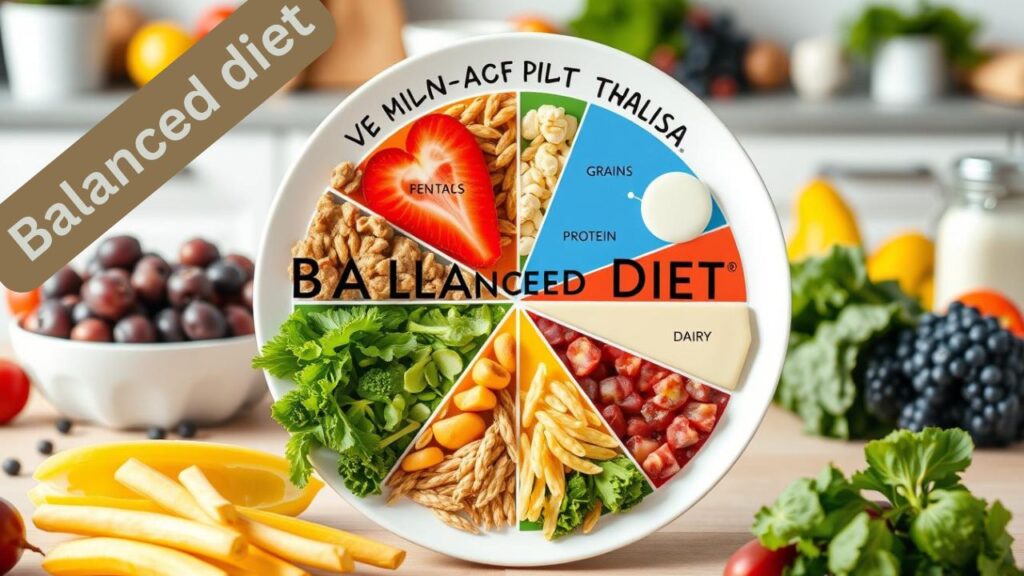
Healthy Cooking Methods to Preserve Nutrients
Choosing the right cooking methods is key to healthy cooking. Low-heat methods like steaming or roasting are top choices. They keep vitamins and minerals in your food, which is great for nutrient preservation.
Grilling, stir-frying, and braising are also good options. They cook food quickly and evenly, saving nutrients. Plus, using herbs and spices for flavor means less salt and sugar.
- Use fresh and seasonal ingredients to ensure your food is rich in nutrients.
- Choose low-heat cooking methods to preserve the vitamins and minerals in your food.
- Don’t overcook your food, as this can lead to a loss of nutrients.
By following these tips and using healthy cooking methods, you can make tasty, nutritious meals. These meals will help you stay healthy and balanced.
Balancing Diet with Different Lifestyle Needs
Keeping a balanced diet is key, especially when your lifestyle affects your nutrition. Different lifestyles need different nutrients. For example, people who are very active might need more protein and carbs for muscles and energy.
On the other hand, those with special dietary needs due to health issues or allergies must watch their nutrient intake. This helps them avoid making their condition worse. By understanding these needs, you can adjust your diet to fit your life and health goals.
Athletes and Active Individuals
- Increased protein intake to support muscle growth and repair
- Complex carbohydrates for sustained energy production
- Adequate hydration to prevent dehydration and support physical performance
Office Workers and Sedentary Lifestyles
People who sit a lot might need fewer calories because they don’t burn as many. But, they should still eat a balanced diet. This includes lots of fruits, veggies, and whole grains for health.
Special Dietary Considerations
Some health conditions, like diabetes or celiac disease, need special dietary needs. Working with a doctor or dietitian can help. They can create a meal plan that fits your health needs and improves your overall well-being.
Common Challenges and Solutions
Keeping a balanced diet can be tough. You might struggle with cravings, unhealthy snacks, eating out, and staying on track during holidays. These dietary challenges can make it hard to reach your goals.
To beat these challenges, you need solutions for balanced diet. Here are some tips to help you overcome common obstacles:
- Plan your meals in advance to avoid last-minute unhealthy choices
- Keep healthy snacks on hand to curb cravings
- Find healthy alternatives to your favorite treats
Using these strategies can help you stay on track. It’s about finding a balance that fits your life.
Here is a table summarizing some common dietary challenges and their solutions:
| Challenge | Solution |
| Cravings | Keep healthy snacks on hand |
| Eating out | Choose healthy options, such as salads or grilled meats |
| Holidays and special occasions | Plan ahead and bring a healthy dish to share |
Knowing these challenges and having solutions can help you overcome dietary challenges. This way, you can keep solutions for balanced diet that suits you.
Staying Motivated on Your Diet Journey
Starting your diet journey is exciting, but staying motivated is key. It’s not always easy, but with the right approach, you can succeed.
Remember why you started your diet. It might be for better health or to feel more confident. Keeping your goals in mind helps you stay focused.
Setting Achievable Goals
Setting goals that you can reach is important. Break big goals into smaller steps. For example, aim to lose 1-2 pounds each week.
Tracking Your Progress
Tracking your progress is crucial. Use a food diary or a mobile app to log your meals and workouts. This helps you see patterns and make diet changes.
Building Healthy Habits
Creating healthy habits is essential. Develop habits like regular exercise, healthy eating, and enough sleep. These habits support your diet goals and keep you on track.
Follow these tips to stay motivated on your diet journey. Stay positive, keep your goals in mind, and celebrate your successes.
Seasonal Adjustments to Your Balanced Diet
As you keep working on your balanced eating habit, think about how seasons affect your diet. Each season brings different needs for nutrients to stay healthy. Making seasonal diet adjustments helps you meet these needs and get the most from your food.
In winter, you might need more vitamin D and omega-3s to fight off cold and short days. Summer calls for more water and electrolytes to replace what’s lost in sweat. These seasonal diet adjustments keep your balanced eating on track for health and well-being.
Here are some seasonal foods to add to your diet:
- Winter: citrus fruits, leafy greens, and root vegetables
- Spring: berries, asparagus, and spinach
- Summer: stone fruits, corn, and bell peppers
- Fall: apples, squash, and Brussels sprouts
By embracing seasonal diet adjustments and focusing on balanced eating, you tailor your diet to your body’s needs. Stay flexible and try new foods and recipes to keep your diet exciting.
| Season | Recommended Foods | Nutritional Benefits |
| Winter | Citrus fruits, leafy greens, root vegetables | Vitamin C, fiber, and antioxidants |
| Spring | Berries, asparagus, spinach | Vitamin C, folate, and iron |
| Summer | Stone fruits, corn, bell peppers | Vitamin C, vitamin A, and potassium |
| Fall | Apples, squash, Brussels sprouts | Fiber, vitamin A, and antioxidants |
The Social Aspects of Healthy Eating
Social eating is key to healthy eating. Sharing meals can be good or bad for your diet. It can bring people together or lead to eating too much.
To eat well in social settings, try these tips:
- Eat mindfully and savor your food
- Choose healthy options when dining out
- Be mindful of portion sizes
- Stay hydrated by drinking plenty of water
Building healthy relationships with food and people is vital. Being smart about social eating helps you stick to your diet. Social eating can be a great way to connect and stay healthy.
Healthy eating habits and smart social eating lead to strong bonds with food and people. This can make life more balanced and fulfilling.
| Benefits of Social Eating | Tips for Healthy Social Eating |
| Encourages healthy relationships | Eat mindfully and savor your food |
| Promotes a sense of community | Choose healthy options when dining out |
| Supports balanced diet | Be mindful of portion sizes |
Conclusion: Embracing a Lifetime of Balanced Eating
As you finish this guide on balanced eating, remember it’s a long-term journey. It’s not a quick fix but a commitment to your health. By following the tips in this guide, you can build a healthy relationship with food for years.
A balanced diet isn’t about being perfect. It’s about finding a way to eat that makes you feel good. Be open to trying new foods and recipes. With effort and a positive attitude, eating well can become a natural part of your life.
Start making changes to your diet today, no matter where you are now. Your body and mind will thank you for the nourishment. Begin this journey with excitement and a focus on your long-term health. You’ll be on your way to a happier, healthier future.
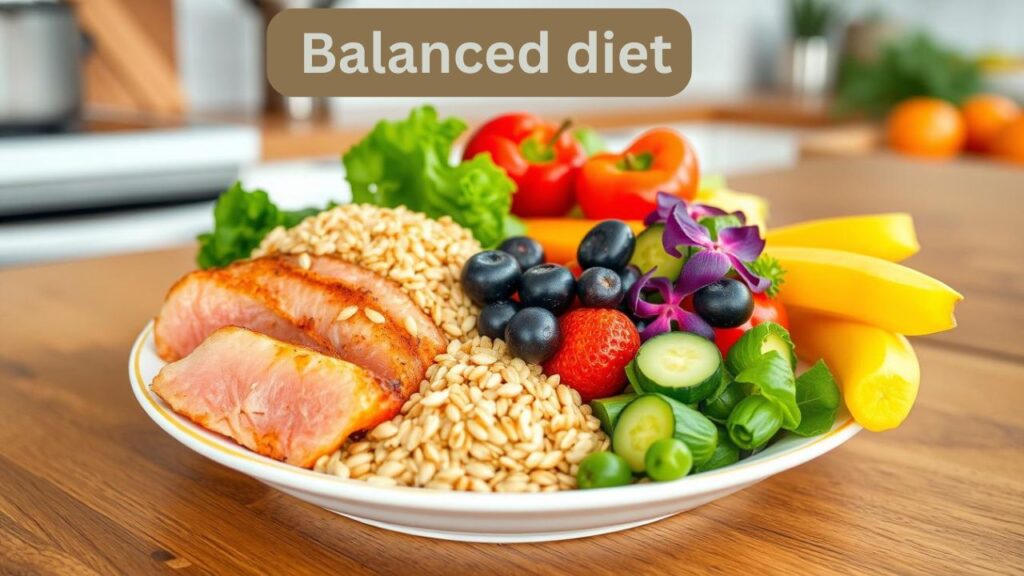
FAQ
What is a balanced diet?
A balanced diet gives your body the nutrients it needs. This includes carbs, proteins, fats, vitamins, and minerals. It helps keep you healthy and supports your body’s functions.
Why is a balanced diet important?
A balanced diet helps you stay healthy. It keeps your weight in check, lowers disease risk, and boosts energy. It also supports your overall well-being.
What are the key components of a balanced diet?
A balanced diet includes carbs, proteins, healthy fats, vitamins, and minerals. These nutrients fuel your body and support its processes.
How do I determine my daily nutrient needs?
Your nutrient needs depend on your age, gender, activity level, and health. A healthcare professional or dietitian can help figure out what you need.
What are macronutrients, and why are they important in a balanced diet?
Macronutrients are carbs, proteins, and fats. They give your body energy and support growth and repair. Getting the right balance is key to a balanced diet.
How can I ensure I’m getting enough micronutrients in my diet?
To get enough micronutrients, eat a variety of fruits, veggies, whole grains, lean proteins, and healthy fats. Reading labels and choosing nutrient-rich foods helps meet your needs.
How do I create a personalized balanced diet plan?
To make a personalized diet plan, assess your needs and set goals. Create a meal schedule that fits your life. Consider your activity level, food likes, and any health conditions.
What strategies can I use for effective portion control?
For portion control, use smaller plates and measure servings. Be aware of your hunger and fullness. Plan meals and snacks to stay on track.
How can I interpret food labels to make informed choices?
When reading labels, look at serving sizes, calories, and nutrient amounts. Check the ingredient list for hidden sugars and unhealthy fats.
What are some common challenges in maintaining a balanced diet, and how can I overcome them?
Challenges include cravings and emotional eating. To overcome them, plan meals, eat mindfully, and find healthy alternatives.
How can I stay motivated and committed to my balanced diet journey?
To stay motivated, set goals, track progress, and build healthy habits. Celebrate small wins, surround yourself with support, and be patient with yourself.